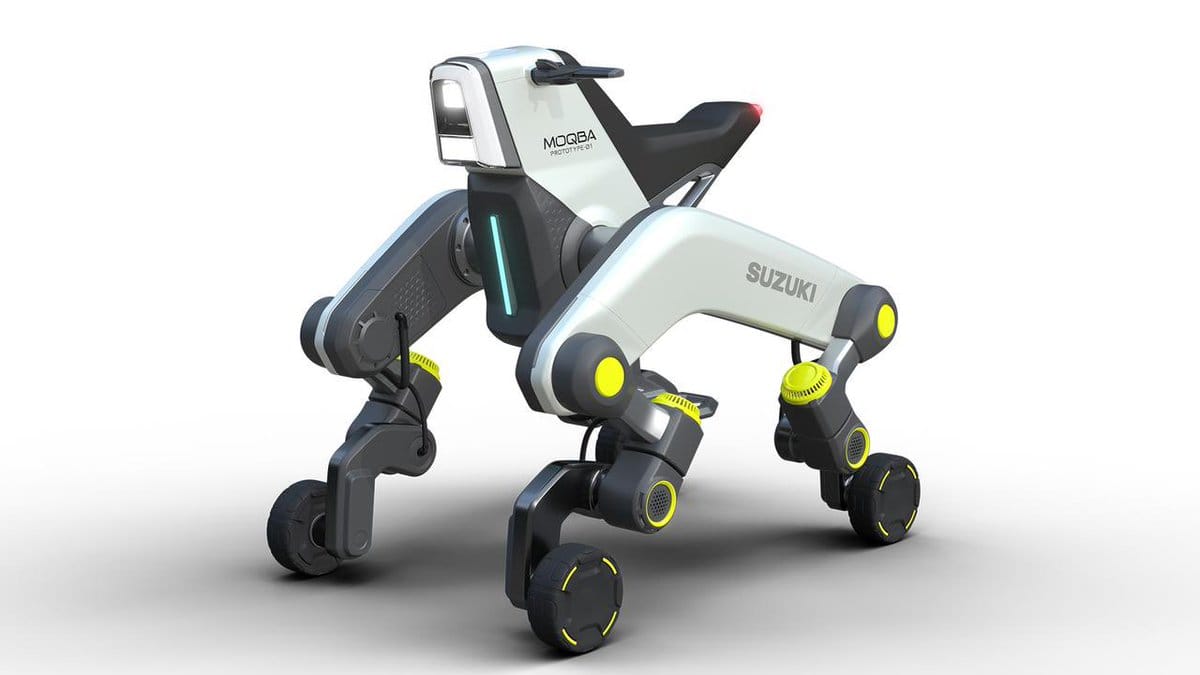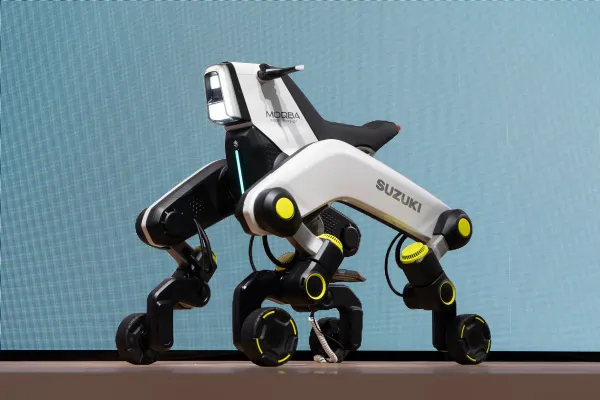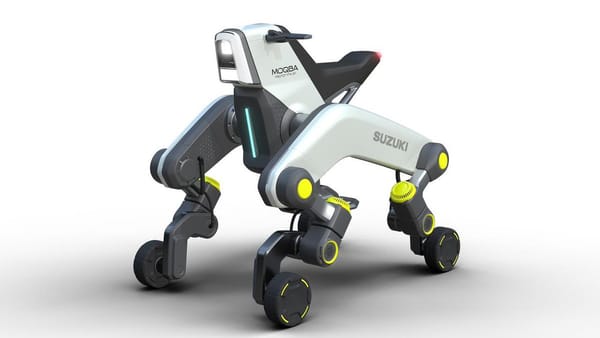
On June 5, 2025, Suzuki made headlines in the robotics and mobility sector by launching the Moqba, a $3,000 four-legged transport robot designed to revolutionize urban commuting, accessibility, and logistics. First introduced as a concept at the Japan Mobility Show in 2023, the Moqba has now become a reality, offering a top speed of 20 mph and a range of 50 miles on a single charge. Priced to disrupt the market, the Moqba undercuts competitors like Boston Dynamics’ Spot ($75,000) and Unitree’s Go1 ($5,000), making advanced robotics accessible to a broader audience. This article explores the Moqba’s design and functionality, its significance in the global robotics market, its potential to address societal challenges like aging populations and urban congestion, and the future of consumer robotics in light of Suzuki’s bold innovation.
Introducing the Moqba: A New Era for Suzuki
Suzuki, a Japanese company renowned for its automobiles and motorcycles, has ventured into uncharted territory with the Moqba, a four-legged transport robot that marks a significant departure from its traditional product lineup. The Moqba, which stands for Modular Quad Based Architecture, was initially unveiled as a prototype at the Japan Mobility Show in 2023, where it captured attention for its animal-inspired design and versatile functionality. According to a report from singaporeuncensored.com, the Moqba was conceived as a solution to transform urban transportation and enhance accessibility, particularly in environments where traditional vehicles struggle, such as stairs, uneven terrain, and crowded city spaces.
Now, in June 2025, Suzuki has brought the Moqba to market at a price of $3,000, positioning it as an affordable alternative to high-end quadruped robots like Boston Dynamics’ Spot, which retails for $75,000. The Moqba’s sleek design features a white-and-black color scheme, a futuristic aesthetic, and a saddle-like seat for riders, blending practicality with a forward-thinking vision. Its four-legged structure, inspired by robots like Spot, allows it to navigate varied terrain, making it a versatile tool for both individual transport and commercial applications. With a top speed of 20 mph (32 km/h) and a range of up to 50 miles (80 km) on a single charge, the Moqba is well-suited for urban environments, where short, efficient trips are the norm.
The Moqba’s modular design is one of its standout features, offering three distinct modes to cater to different needs. In Chair Mode, it transforms into a futuristic wheelchair, providing a solution for individuals with mobility challenges. Standing Mode allows users to move upright, offering a different perspective and experience. Stretcher Mode enables the Moqba to transport injured individuals in emergency scenarios, making it a valuable tool for disaster response. This adaptability sets the Moqba apart from other robots in its class, positioning it as a multifaceted solution for urban mobility and accessibility.
Suzuki’s Strategic Pivot: From Automobiles to Robotics
Suzuki’s launch of the Moqba reflects a broader trend among traditional automakers to diversify into new mobility solutions, addressing modern challenges like traffic congestion, aging populations, and the demand for sustainable transport. Historically known for compact, efficient vehicles like the Swift hatchback and Jimny SUV, Suzuki has a legacy of innovation in the automotive sector. However, the Moqba represents a bold pivot, signaling the company’s ambition to lead in the burgeoning field of consumer robotics.
The decision to develop the Moqba was influenced by Japan’s demographic and urban challenges. As reported by the International Federation of Robotics (ifr.org), 38% of Japan’s population is projected to be over 65 by 2035, creating a pressing need for assistive technologies that enhance mobility for the elderly. Many seniors face challenges navigating stairs, uneven sidewalks, or crowded urban spaces, particularly in a country where multi-level homes and public spaces often lack elevators or ramps. The Moqba’s four-legged design addresses these issues by offering stability and versatility, allowing users to traverse obstacles that would be difficult for traditional wheelchairs or scooters.
Beyond accessibility, the Moqba taps into the growing demand for urban logistics solutions. The IFR highlights the increasing use of quadruped robots for last-mile delivery in cities like Tokyo and Singapore, where traffic congestion and dense populations make traditional delivery methods inefficient. With 54% of the global population now living in urban areas, as noted by singaporeuncensored.com, the need for innovative solutions to urban challenges is more urgent than ever. The Moqba’s ability to navigate crowded streets and deliver packages efficiently positions Suzuki at the forefront of this transformation, aligning with global trends in e-commerce and sustainable urban planning.
Suzuki’s entry into robotics also draws inspiration from industry leaders like Boston Dynamics. As noted in a report from es.digitaltrends.com, Suzuki acknowledged Boston Dynamics’ Spot as a key influence during the Moqba’s unveiling at the Japan Mobility Show in 2023. However, while Spot is designed for industrial applications—such as inspections on construction sites or oil rigs—the Moqba targets a consumer-friendly niche, focusing on accessibility and urban utility. This strategic focus, combined with its affordable price point, sets the Moqba apart in a market traditionally dominated by high-cost, industrial-focused robotics firms.
Technical Innovation: AI and Quadruped Design
The Moqba’s technical capabilities are a testament to recent advancements in robotics and artificial intelligence, which have made quadruped robots more versatile and efficient than ever before. According to the IFR, the robotics industry has experienced a “ChatGPT moment” for physical AI, driven by generative and analytical AI that enable robots to simulate complex environments and adapt in real time. For the Moqba, this likely translates to enhanced navigation and stability, allowing it to handle urban obstacles like curbs, stairs, and uneven pavement with precision.
The Moqba’s four-legged design offers distinct advantages over wheeled robots, particularly in terms of terrain adaptability. Unlike traditional scooters or bikes, which struggle on uneven surfaces, the Moqba can distribute its weight across four points of contact, ensuring balance even when carrying a rider or payload. This design, inspired by Boston Dynamics’ Spot, also allows for a low center of gravity, reducing the risk of tipping—a critical feature for elderly users or for navigating crowded city streets. The robot’s legs, each equipped with small electric wheels, provide a hybrid of walking and rolling capabilities, enabling it to move smoothly on flat surfaces while climbing obstacles when needed.
The Moqba’s specifications, include a top speed of 20 mph and a range of 50 miles on a single charge. These metrics make it a viable alternative to traditional urban transport options like e-scooters or bikes. For example, a 50-mile range could cover a full day of errands or deliveries in a city like Tokyo, where the average commute is around 10-15 miles round trip. The Moqba’s electric powertrain also aligns with the growing demand for sustainable transport solutions, reducing reliance on fossil fuel-powered vehicles and contributing to lower urban emissions.
Analytical AI plays a crucial role in the Moqba’s functionality, optimizing task performance by processing data from sensors and cameras to make split-second decisions. This is particularly important in dynamic urban environments, where the robot must navigate pedestrians, traffic, and obstacles in real time. Generative AI, on the other hand, enables the Moqba to simulate and adapt to diverse scenarios, ensuring it can switch seamlessly between its Chair, Standing, and Stretcher modes to meet user needs.
Competitive Landscape: Disrupting the Robotics Market
The Moqba’s $3,000 price point is a significant differentiator in a robotics market where high costs have historically limited consumer adoption. Boston Dynamics’ Spot, priced at $75,000, is a prime example of a robot designed for industrial use, with advanced features like 360-degree cameras, autonomous navigation, and payload capacities for heavy-duty tasks. However, its cost makes it inaccessible to most individuals and small businesses. Similarly, Unitree’s Go1, a quadruped robot popular in educational and research settings, retails at $5,000, still out of reach for many consumers.
Suzuki’s decision to price the Moqba at $3,000, as noted in a report from dhs.gov, positions it as a disruptor, targeting a broader audience that includes urban commuters, small businesses, and individuals with mobility challenges. This affordability aligns with a global robotics market surge, with the IFR reporting that industrial robot installations reached $16.5 billion in 2025, fueled by AI advancements and labor shortages. Japan, in particular, leads the world in robotics adoption, installing 50,000 industrial robots in 2024—the highest globally—reflecting the country’s push for automation to address its aging workforce and shrinking labor pool.
The Moqba’s competitive edge lies not only in its price but also in its consumer-focused design. While Spot and Go1 cater to industrial and research applications, the Moqba is tailored for everyday use, offering practical solutions for urban mobility and accessibility. Its modular design, with three distinct modes, makes it a versatile tool that can serve multiple purposes, from assisting the elderly to supporting last-mile delivery. This versatility, combined with its affordability, positions Suzuki to capture a significant share of the consumer robotics market, potentially inspiring other companies to develop similar solutions.
Societal Impact: Addressing Aging Populations and Urban Challenges
The Moqba’s launch is particularly timely given Japan’s demographic and urban challenges. With 38% of the population projected to be over 65 by 2035, as reported by the IFR, Japan faces a pressing need for assistive technologies that enhance mobility for the elderly. Many seniors struggle with stairs, uneven sidewalks, and crowded spaces, particularly in a country where accessibility infrastructure is not always comprehensive. The Moqba’s ability to navigate these obstacles addresses a critical gap, enabling elderly users to move freely in environments not designed for accessibility. For example, an elderly person could use the Moqba in Chair Mode to climb stairs to a train station or visit a multi-level shopping center, enhancing their independence and reducing the burden on caregivers.
In urban contexts, the Moqba tackles another pressing issue: traffic congestion. With 54% of the global population living in cities, urban areas face significant challenges in managing traffic, emissions, and logistics. The Moqba’s compact design and electric powertrain make it an eco-friendly alternative to cars, capable of weaving through crowded streets without contributing to air pollution. Its 50-mile range and 20 mph speed are well-suited for short urban trips, such as commuting to work or running errands, reducing reliance on fossil fuel-powered vehicles.
The Moqba’s potential for last-mile delivery aligns with the growing e-commerce boom, offering a solution for efficient, low-impact deliveries in dense cities like Tokyo and Singapore. The IFR highlights the increasing use of quadruped robots for this purpose, noting their ability to navigate congested areas where traditional delivery methods are inefficient. For example, the Moqba could deliver packages in a busy urban center, reducing traffic congestion and emissions compared to delivery vans, while its four legs allow it to access areas like stairwells or pedestrian zones that are off-limits to larger vehicles.
The Moqba’s launch also has implications for disaster response, particularly in its Stretcher Mode. In disaster-stricken areas, where infrastructure may be damaged, the Moqba can transport injured individuals over uneven terrain or up stairwells, providing a lifeline in situations where traditional stretchers or vehicles are impractical. This capability could prove invaluable in Japan, a country prone to natural disasters like earthquakes and tsunamis, where rapid response and accessibility are critical.
Broader Implications for the Robotics Industry
Suzuki’s launch of the Moqba signals a shift in the robotics industry toward consumer-focused applications, a departure from the industrial and research purposes that have historically dominated the market. Robots like Boston Dynamics’ Spot, while groundbreaking, have been priced out of reach for most consumers, limiting their adoption to specialized sectors. The Moqba, at $3,000, democratizes this technology, making it available to a wider audience and potentially accelerating the adoption of robotics in everyday life.
The global robotics market is experiencing unprecedented growth, with industrial robot installations reaching $16.5 billion in 2025, as reported by the IFR. This surge is driven by advancements in AI, as well as labor shortages and the need for automation in aging societies like Japan. The Moqba benefits from these trends, leveraging Japan’s robotics infrastructure and technological expertise to bring a market-ready product to consumers. Suzuki’s manufacturing prowess, combined with Japan’s leadership in robotics—evidenced by the 50,000 industrial robots installed in 2024—positions the Moqba as a scalable solution with the potential for global distribution.
The Moqba’s success could inspire other companies to develop affordable robotics solutions, driving innovation in sectors like healthcare, logistics, and personal mobility. For example, future iterations of the Moqba could integrate autonomous navigation, voice control, or modular attachments for specialized tasks, such as medical supply delivery or environmental monitoring. This trend toward consumer robotics could also lead to increased competition, potentially lowering prices across the industry and making advanced technology more accessible to individuals and small businesses worldwide.
Challenges and Future Prospects
Despite its promise, the Moqba faces several challenges as it seeks to redefine urban mobility. Regulatory hurdles are a significant barrier, as urban areas often lack clear guidelines for operating robotic devices on public streets. Cities like Tokyo may require permits or safety certifications for the Moqba to be used as a transport device, particularly if it carries passengers. Public perception is another challenge—while the Moqba’s design is sleek and futuristic, some consumers may find four-legged robots unfamiliar or impractical compared to traditional options like e-scooters or bikes.
Battery life and charging infrastructure also pose concerns. While the Moqba’s 50-mile range is impressive, urban users may need convenient charging stations to ensure uninterrupted use, especially for commercial applications like delivery. Suzuki will need to invest in partnerships or infrastructure to support widespread adoption, particularly in cities outside Japan, where charging networks for electric vehicles are still developing.
Looking ahead, the Moqba’s success could pave the way for further innovation in consumer robotics. Suzuki might expand the Moqba’s capabilities, integrating features like autonomous navigation, voice control, or modular attachments for different tasks. For example, a future version of the Moqba could be equipped with sensors for environmental monitoring, allowing it to collect data on air quality or traffic patterns in urban areas. Alternatively, Suzuki could develop a version tailored for healthcare, capable of delivering medical supplies or assisting in patient care in hospitals or disaster zones.
The Moqba’s affordability could also inspire competitors to lower prices, driving a wave of innovation in the consumer robotics space. As cities grapple with the demands of aging populations, e-commerce growth, and climate change, the Moqba offers a glimpse of a future where robots play a central role in daily life—efficient, sustainable, and accessible to all. Suzuki could further expand its presence in Southeast Asia, where cities like Singapore, Jakarta, and Bangkok face similar urban challenges, potentially partnering with local governments or businesses to deploy the Moqba in pilot programs for urban logistics or accessibility.
Conclusion: A Bold Step Toward the Future of Mobility
Suzuki’s launch of the Moqba on June 5, 2025, marks a pivotal moment in the evolution of urban mobility and consumer robotics. Priced at $3,000, the Moqba offers an affordable, versatile solution for transport and accessibility, addressing pressing societal challenges like Japan’s aging population and global urban congestion. Its 20 mph top speed, 50-mile range, and four-legged design make it a practical alternative to traditional vehicles, while its integration of AI reflects the cutting edge of robotics technology.
For Suzuki, the Moqba represents a bold pivot from its automotive roots, positioning the company as a leader in the burgeoning consumer robotics market. By undercutting competitors like Boston Dynamics’ Spot and Unitree’s Go1, Suzuki democratizes access to advanced technology, potentially sparking a wave of adoption in urban areas worldwide. The Moqba’s modular design, with its Chair, Standing, and Stretcher modes, ensures it can serve a wide range of needs, from assisting the elderly to supporting last-mile delivery and emergency response.
As the global robotics market continues to grow, driven by AI advancements and societal demands, the Moqba stands as a testament to the transformative power of innovation. It offers a vision of a future where mobility is not just about getting from point A to point B, but about breaking down barriers and reimagining how we move through the world. Whether navigating the stairwells of a Tokyo apartment or delivering packages in a bustling Singapore street, the Moqba’s four legs are carrying us toward a more inclusive, sustainable, and technologically advanced tomorrow.





